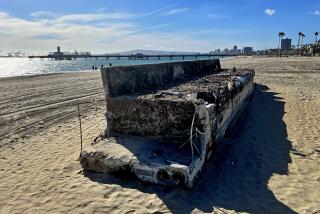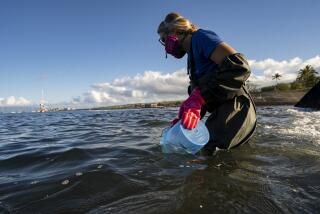UCSD discovers surge in plastics pollution off Santa Barbara
The claim was made in the latest in a series of scientific studies about the presence of plastics in the sea
UC San Diego researchers say they have discovered an “explosion of plastics pollution” in the seafloor off Santa Barbara, in an area where little of the material appeared to exist before the end of World War II.
The university’s Scripps Institution of Oceanography says the surge may reflect the boom in plastics production that occurred worldwide after the war, largely for use in consumer products, ranging from bottles to clothing.
Much of the so-called microplastic was carried into the ocean by storm runoff or in the flow from wastewater treatment plants, and became embedded in sea floor sediment, said Jennifer Brandon, a Scripps biologist who specializes in plastics.
Brandon and her colleagues examined layers of sediment that covered the period from 1834 to 2010, and published their findings Wednesday in the journal Science Advances.
“We barely found trace amounts of microplastics in layers from the 1940s,” Brandon told the Union-Tribune. “But you can easily see the plastics in the more recent layers. There’s been an exponential increase.”
Scripps took core samples a few miles from shore, in 1,900-feet of water, at a spot where the physical makeup of the ocean helps to preserve layers of sediment. Most of the plastic fragments are smaller than a piece of lint.
“We’re using more and more of plastic and it’s showing up as a footprint on the seafloor,” Brandon said. “It begs the question: Is this what our civilization is going to be remembered for?”
Not all plastic descends to the seafloor. Much of it floats at or near the surface. Scripps scientists helped clarify this point in 2009 when they conducted a landmark study of the Great Pacific Garbage Patch, an immense area of debris roughly 1,000 miles off San Diego.
More recently, Scripps researchers discovered microplastics in water up to 3,300 feet off Monterey. And explorer Victor Vescovo found plastic waste at the bottom of the Mariana Trench in the western Pacific, the deepest spot on Earth.
Scientists have so far produced only broad estimates of the amount of plastics in the ocean. And there’s no clear consensus of how it’s affecting marine life. Brandon called it “the great unknown.”
More to Read
Start your day right
Sign up for Essential California for news, features and recommendations from the L.A. Times and beyond in your inbox six days a week.
You may occasionally receive promotional content from the Los Angeles Times.







